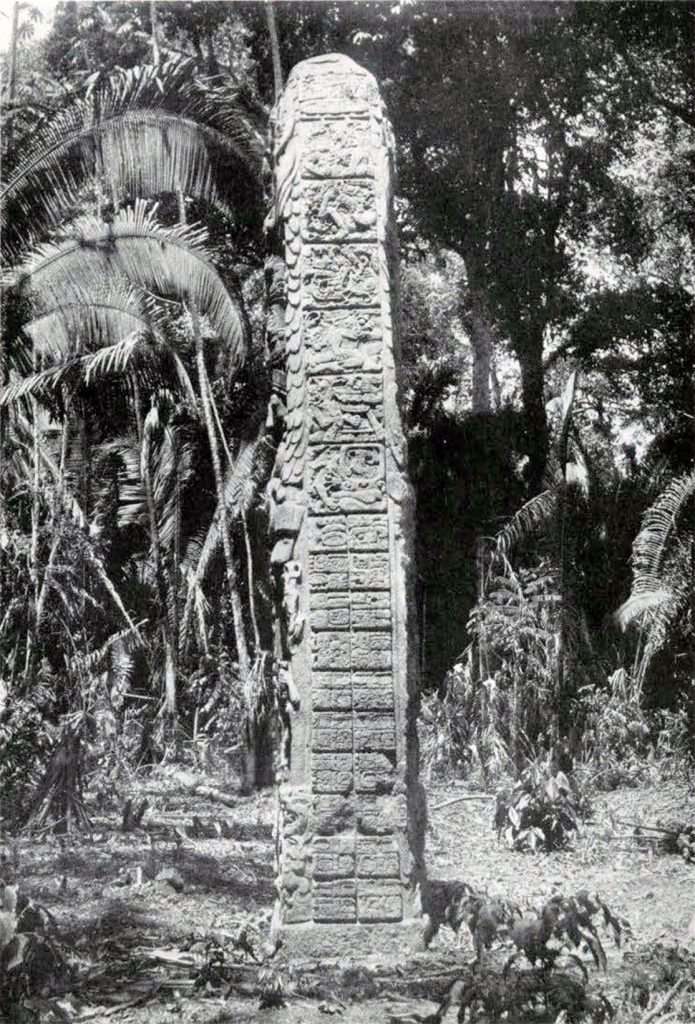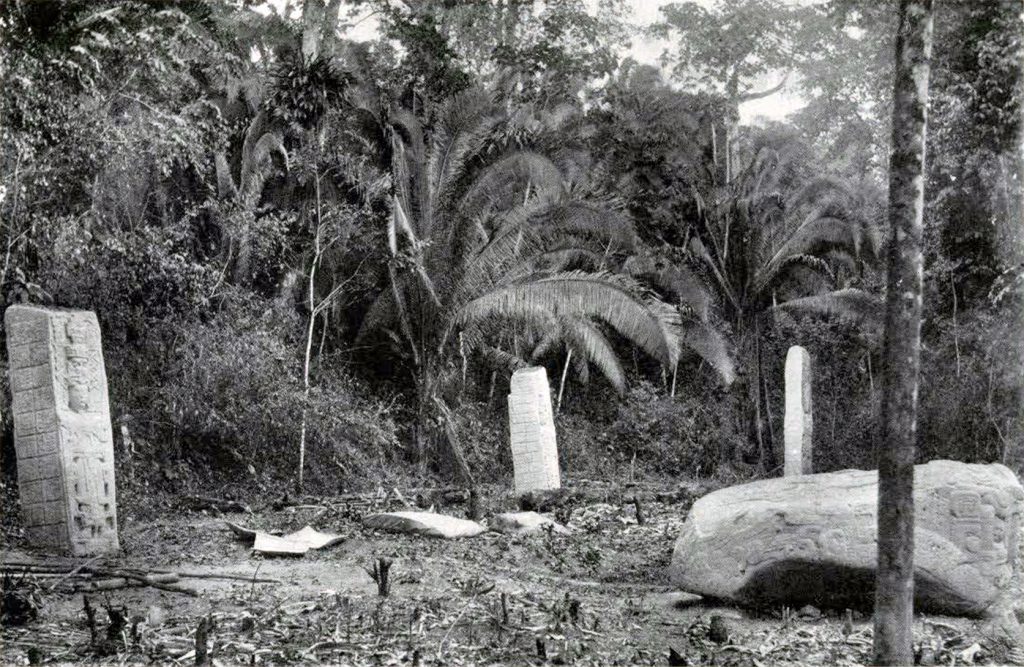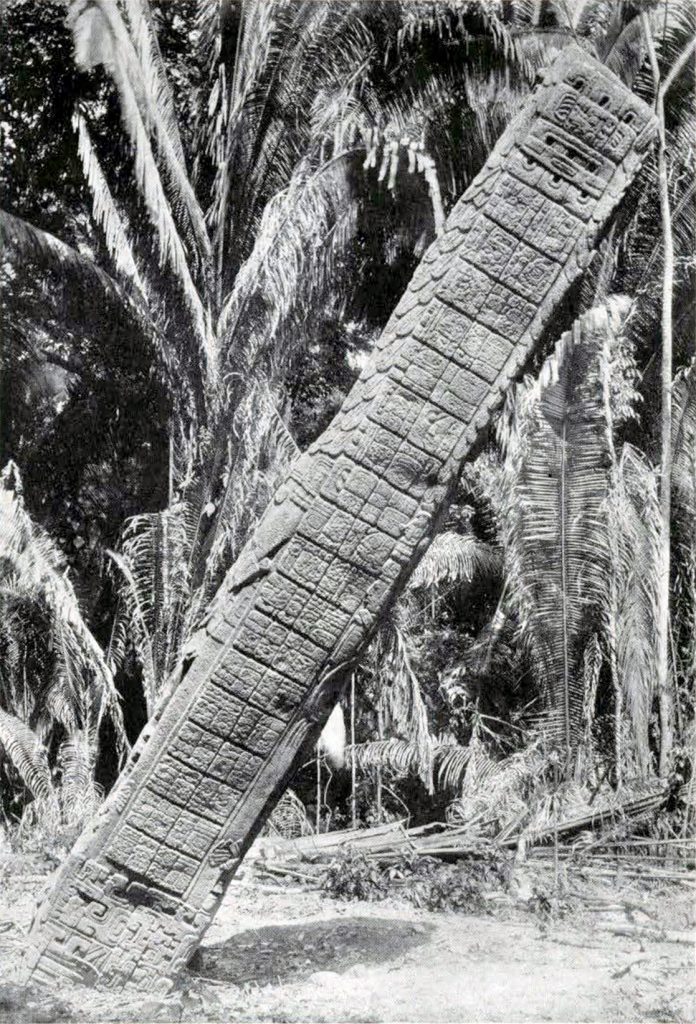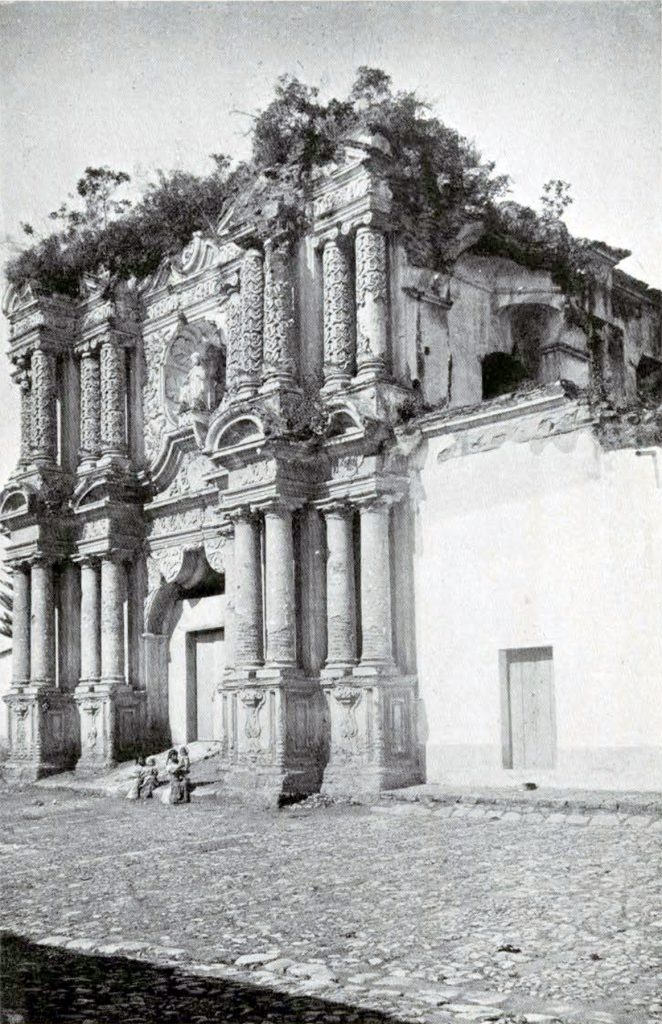In Guatemala are many high mountains and many fertile valleys with beautiful lakes and running streams. Nowhere in the world is there a fairer land and no part of it is more fair than the region known as the Alta Vera Paz or the High True Peace. In earlier times this region was called Tierra De La Guerra, the Land of War, because the Kekchi Indians who inhabited these highlands resisted the Spaniards so bravely that the invaders could make no progress against them. Then the great priest, Las Casas, said that if the soldiers were withdrawn, he would agree to conquer the Indians with a company of monks. The plan succeeded so well that the name of the country was changed from the Land of War to the Land of Peace. The victory which was thus peacefully achieved has left its mark upon the Indians to this day, for in most of their villages there is to be found a cross and a shrine to the Virgin. At the same time, the religious rites observed in these villages are often more pagan than Christian. Moreover, the Indians of the Alta Vera Paz retain their own language, and the men and women wear the same costumes as did their ancestors. The native arts and industries have not been affected by the peaceful conquest of the sixteenth century. In their manners and customs and in all that pertains to their domestic life, the Indians of the Alta Vera Paz scarcely differ today from their ancestors at the time of Las Casas. They are a gentle folk, leading an industrious and altogether wholesome existence in the peaceful land of their fathers.
Guatemala is a land which in its beautiful and romantic scenery may be said to resemble Greece. Like the ancient Greeks, the people of Guatemala have, from the most remote times, peopled their mountains and valleys and forests and rivers and plains with gods and demi-gods, demons and spirits. In other ways, too, the Guatemala people resemble the ancient Greeks.
I have been so fortunate recently as to receive from a friend in Guatemala, whose name I regret to say I am not permitted to use, a number of notes relating to the native customs, together with a collection of tales related by members of the Kekchi tribe. Among the beliefs which the Kekchis share with all their neighbors, none is more common or persistent than the belief in El Sisemite. This is the name by which he is most commonly known. Among the Kekchis he is known as Li Queck.
El Sisemite
There is a monster that lives in the forest. He is taller than the tallest man and in appearance he is between a man and a monkey. His body is so well protected by a mass of matted hair that a bullet cannot harm him. His tracks have been seen on the mountains, but it is impossible to follow his trail because he can reverse his feet and thus baffle the most successful hunter. His great ambition, which he has never been able to achieve, is to make fire. When the hunters have left their camp fires he comes and sits by the embers until they are cold, when he greedily devours the charcoal and ashes. Occasionally the hunters see in the forest little piles of twigs which have been brought together by El Sisemite in an unsuccessful effort to make fire in imitation of men. His strength is so great that he can break down the biggest trees in the forest. If a woman sees a Sisemite, her life is indefinitely prolonged, but a man never lives more than a month after he has looked into the eyes of the monster. If a Sisemite captures a man he rends the body and crushes the bones between his teeth in great enjoyment of the flesh and blood. If he captures a woman, she is carried to his cave, where she is kept a prisoner.

Besides his wish to make fire, the Sisemite has another ambition. He sometimes steals children in the belief that from these he may acquire the gift of human speech.
When a person is captured by a Sisemite the fact becomes known to his near relations and friends, who at the moment are seized with a fit of shivering. Numerous tales are told of people who have been captured by the Sisemite. The following incident is related by a woman who had it from her grandmother.
A young couple, recently married, went to live in a hut in the woods on the edge of their milpa in order that they might harvest the maize. On the road Rosalia stepped on a thorn and next morning her foot was so sore that she was unable to help Felipe with the harvesting, so he went out alone, leaving one of their two dogs with her. He had not been working long when the dreaded feeling, which he recognized as Sisemite shivers, took hold of him and he hastily returned to the hut to find his wife gone and the dog in a great fright. He immediately set out for the village, but met on the road the girl’s parents, who exclaimed, “You have let the Sisemite steal our child, our feelings have told us so.” He answered, ” It is as you say.”
The case was taken up by the authorities and investigated. The boy was cross-examined, but always answered, “The Sisemite took her, no more than that I know.” He was, in spite of the girl’s parents’ protests, suspected of having murdered his young wife, and was thrown into jail, where he remained many years.
At last a party of hunters reported having seen on Mount Kacharul a curious being with hairy body and flowing locks that fled at sight of them. A party was organized which went out with the object of trying to capture this creature at any cost. Some days later this party returned with what seemed to be a wild woman, of whom the leader reported as follows. “On Mount Kacharul we hid in the bushes. For two days we saw nothing, but on the third day about noon this creature came to the brook to drink and we captured her, though she struggled violently. As we were crossing the brook with her, a Sisemite appeared on the hillside, waving his arms and yelling. On his back was a child or monkey child which he took in his hands and held aloft as if to show it to the woman, who renewed her struggle to be free. The Sisemite came far down the hill almost to the brook; he dropped the child and tore off great branches from big trees which he threw at us.”
The young man was brought from his cell into the presence of this wild creature and asked if he recognized her. He replied, “My wife was young and beautiful; the woman I see is old and ugly.” The woman never spoke a word and from that time on made no sound. She refused to eat and a few days after her capture she died.
Felipe lived to be an old man and the grandmother of the woman who told this story remembered him as the man whose wife had been carried away by the Sisemite.

The Enchanted Bull
On Sactzicuil, a hill in the Alta Vera Paz, there was once an enchanted bull made of pure gold. The Kekchis held fetes in honor of this bull and worshipped him. At stated seasons all the people turned out to adorn his home with flowers, to fan him with the fragrant smoke of burning copal and to dance about him to the accompaniment of music. At last, however, the bull sank down into the hill. When this happened a wizard, mighty in magic among the Kekchis, ordered one half of the women of the tribe to wear the tupuy in memory of the bull’s tail and the other half to cut their hair in a certain fashion in memory of his ears. And to this day some of the women of this tribe smooth their hair down to the nape of the neck and then wrap it round and round with a cord of red wool until it is as thick and as long as a bull’s tail. The other women of the tribe cut a lock of hair on each side of the forehead and these locks hang down like the two big ears of the bull.
The Storm
Reponcace, the lightning, is a big fish with dazzling fins that lives deep in the sea. Cace, the thunder, is a very old man whose voice is harsh and loud and who dwells in thirteen green hills. Sometimes the big fish comes up from the depths of the ocean to sport and play, and when by chance one of his fins rises above the water its brilliancy illumines earth, air and sea. This angers the old man of the hills, who roars till the earth and air tremble. These two, the flash of the fish’s scales and roar of the old man’s voice, bring down the rain, but when it is over all is once again calm and beautiful, for the fish returns to the deep sea and the old man of the thirteen green hills falls asleep.
The River Gods

The Indians never drink cold water. When asked to explain this, they say, ” Water when it is cold is bad for our stomachs.” About an Indian’s house there are always small earthen pitchers or jars that can be filled with water and set against the fire that constantly smoulders in the middle of the floor. No Indian starts on a journey without a small bundle of dry twigs for starting a fire and a little jug for heating water.
In the Alta Vera Paz there are numerous streams; some are cool, some are warm and some are salt. These streams often become rushing torrents during the rainy season. Between Teleman and La Tinta, two small towns, there is a stream crossed by a road much frequented by the Indians. Being warm, the water of this stream is much loved by the Indians, who usually take a draught in passing to quench their thirst. An Indian arriving at this stream during the rainy season invariably casts his bundle of dry fagots in the stream, which rapidly bears it away, but if the time of his passing takes place in the dry season when the current is not sufficient to bear the bundle of fagots away, he carefully deposits it in some convenient spot on the bank and every Indian who comes after him does likewise, thus increasing the pile until it is often six feet high. When the rain falls and the stream rises it carries this pile away.
When the Indian casts his fagots on the water he is sending them to a man and a woman who, according to his belief, live at the source of the stream and who never grow old because their youth is yearly renewed. The object of casting the fagots in the stream is that these spirits may not want fuel to keep the water warm. When the river rises and bears the pile on the bank away, the Indian says, “The young people have taken the fagots so we shall have warm water all this season.”
The Toothache
When a Kekchi Indian has toothache he says he has xul-hé, which means that the mouth maggot is troubling him, and he goes in search of the medicine man who alone can drive it out.
The patient seats himself, the medicine man stands behind him, gently rubs over the seat of pain and he addresses the xul-hé in the following incantation.
I know thee, thou insect, thou xul-hé
Thou thinkest no man knows by whom thou wert begotten;
Nor from whence thou comest. But I know,
For great snakes are sons of mine.
I have power. I have poison to quench thy fires; to annul thy power.
I am thy father and thy mother.
I know that thou comest from an ear of corn on the highest stalk in the biggest milpa around here.
As I am thy father and thy mother, I have authority over thee. And I bring three remedies the like of which thou has never seen
before. Any one of these will quiet—will quiet thee by casting
out thy vexation :
By driving out thy sweetness and thy wrath.
[The medicine man here places the bruised leaves of an herb called quejen in the patient’s mouth and continues,]
I drive thee to the bottom of the great lake.
Here thou shalt go into a cave.
Behind the largest stalactite in this cave there lives a monster crab.
He will bind thee to a red water plant.
Failing this he will bind thee to a rotting twig near a rock at the
bottom of the lake.
A little of thy might—a little of thy power,
Shall I borrow from a green hill, from a pleasant valley.
Oh! mighty spirit of the thirteen valleys.
Oh ! mighty spirit of the thirteen mountains.
Aid me in casting out this pain-giving mouth insect.

The medicine man then gently passes his hands over the patient’s face while he whistles softly.
“Depart! Go forth!” he says, as he blows on the seat of pain. The xul-hé departs, and the relieved patient must take his leave without looking back.
It will doubtless strike many readers that the belief that the toothache is caused by a worm pertains to Chinese medicine and that the medicine man’s performance suggests a borrowed custom. That such should be the case is not credible. The belief itself and the method of cure are clearly native to America and furnish an example of native medicine and magic.
This may be illustrated by reference to a famous Indian document. The Popol Vuh is the sacred book of the Quiches, another great Guatemala tribe living southwestward from the Kekchis. The Popol Vuh was written a few years after the Conquest, by a member of the royal family of the Quichés who had learned to use the Roman alphabet in writing his own language. It was translated from the Quiche language into Spanish in the seventeenth century by Father Ximenez, a Dominican priest. The book relates the doings of the gods and the creation of the world. In one passage it tells of a battle between a giant and two demi-gods during which the giant has his teeth broken. Afterwards the demi-gods come to him disguised as medicine men.

“What ills do you cure?” asks the giant, holding his aching jaw.
“We extract maggots from the teeth to make them stop aching,” answered the false medicine men.
“Then cure my toothache,” said the giant.
“That we will do,” replied the others, “for it is only maggots that cause the pain. We can even pull your teeth and give you new ones of ground bone.”
Then the false medicine men pulled all the giant’s teeth and put out his eyes.
In the story called the Horned Serpent p. 124, there is again a reference to a maggot as the cause of toothache.
The tales which follow, like the beliefs already described, are not an exclusive possession of the Kekchis, but seem to be the common property of all the tribes of Guatemala, of which there are no less than eighteen. They are also well known among people of Spanish descent or of mixed blood.
In reading these tales it has occurred to me that they contain elements from three different sources: some are purely aboriginal, others appear to present European characteristics and to be derived from European sources, while a third group has a flavor so distinctly characteristic of African folk tales that they would seem to be African in their origin. It is necessary, however, to be cautious in reaching such a conclusion, for it is not always easy to classify these myths and assign them with certainty to their several origins. Some of those which at first sight appear European in character are found to contain allusions to native beliefs and to reflect the native mind. It must be remembered that they were related in the Kekchi language and the versions which I give were rendered first into Spanish and then into English.
Without attempting any analysis of these myths, I give the readers of the JOURNAL several selections which illustrate the three types to which I refer.
The first myth, which has the moon for its subject, has been received in two versions which are so interesting that I present them both. These I believe to be entirely aboriginal. The same is true of the Horned Serpent. The five that follow belong to the group in which European influence is suspected and the last two appear to be African.
G. B. G.
*Stories collected and translated by Mary Owen, Guatemala City. See correspondence with G.B.Gordon in the Director’s Office Records; original type written versions are with the Central American Expedition Records.

